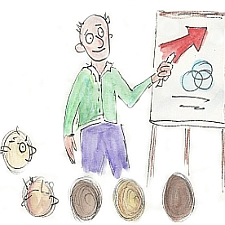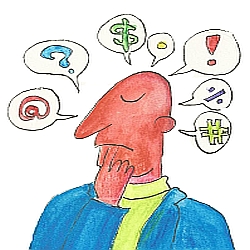by Susan Johnston | Dec 9, 2014 | Uncategorized |
 I was raised to believe that we make our own opportunities. That’s easy to believe when your family and community provide you with safe places to live and play, a great education, three squares a day, inspiring role models and a comforting hug when things go wrong. As a child growing up in a fortunate home, I didn’t really have to create opportunities. I just had to notice them and do something with them.
I was raised to believe that we make our own opportunities. That’s easy to believe when your family and community provide you with safe places to live and play, a great education, three squares a day, inspiring role models and a comforting hug when things go wrong. As a child growing up in a fortunate home, I didn’t really have to create opportunities. I just had to notice them and do something with them.
Did I make the most of these opportunities? Who can say? What I do know is that I’ve reached the stage and age at which creating opportunities for others is increasingly important.
The best leaders help others succeed. Management author John Maxwell asks, “When opportunity knocks, do you answer the door and hold it open for others?”
We understand “opportunity” to mean a situation that can lead someone to reaching a goal. How do we create those opportunities? How can creating them become a habit, not just something we do at Christmas? Or because it’s 12 Days For Good? How do we do it when we aren’t the sort of people who can write large cheques to worthy causes?
Here are some questions to ponder:
When I reflect on my own life, who created opportunities for me?
What did those opportunities look like?
Were they aware they were creating them?
Did those people have to risk something to create those opportunities for me?
Can I do what they did?
Who am I creating opportunities for?
How can I amplify those opportunities by joining with others in my community?
Opportunities for us to create opportunities for others are everywhere.
This is a blog series inspired by House of Friendship Kitchener’s 12 Days for Good project. There’s a theme for each of the 12 days – no Turtle Doves required. Learn more at http://12daysforgood.com
by Susan Johnston | Dec 8, 2014 | Uncategorized |
 A few weeks ago, I put together a personal list of Coaching Values. One of them is compassion. Today, I’m examining, more deeply, what it means.
A few weeks ago, I put together a personal list of Coaching Values. One of them is compassion. Today, I’m examining, more deeply, what it means.
It’s the theme for the first of the 12 Days of Christmas, when House of Friendship, a local charitable social services agency, invites the Kitchener-Waterloo community to take part in 12 Days for Good. We commit to doing something good every day for our favourite causes and our community. Each day has a theme – today, it’s compassion.
As I consider compassion and what it means in my own life, as a coach and as a person – and try to think of ways to demonstrate it – I see that it’s not simply a feeling. It requires action. Or so it seems to me. Even the dictionary definition indicates a desire to alleviate the suffering.
Compassion (n) – a feeling of deep sympathy and sorrow for another who is stricken by misfortune, accompanied by a strong desire to alleviate the suffering.
Though they’re sometimes used interchangeably, sympathy, empathy and compassion are quite different. All involve feeling, but it’s the depth of the feeling and what emerges from it that make the distinction.
Sympathy – When I feel sympathy, I feel FOR you. I feel sad that you’re having a bad time, but there is distance between me and your pain. I don’t actually feel it. It’s more of an intellectual exercise than a participative one. I can recognize that things are awful for you, but I’m not affected.
Empathy – When I feel empathy, I feel WITH you. I tune into your emotional experience. I more than intellectualize what you’re going through, I vicariously experience some of it. Whether or not I have gone through a similar experience, I can imagine what it would be like and, in my brain, my understanding of your emotion has me experiencing it, myself. I am definitely affected, sometimes profoundly.
Compassion – When I feel compassion, my empathy provokes me to take action. Doing something seems to be the distinguishing feature of compassion. True compassion puts your needs ahead of my own. I stand with you.
Here’s an example
We see a homeless person huddled in a public space, her shopping bags piled around her, and think, “Poor woman. Must be awful to live that way. I wonder what her story is.” We walk around her and go about our business. That is sympathy. We notice her plight and may feel sad for her, but don’t identify with it or with her.
When we see her and imagine what it means to be cold and alone, with nowhere to go and living on the streets, we’re closer to empathy. We begin to feel her fear, despair, anger, hope, confusion. We can imagine ourselves in her situation and experience strong feelings. We are touched, sorrowful, upset. When we feel the feeling and stop there, that is empathy.
When the emotions we feel when we encounter this homeless woman cause us to do something to help her or others in her situation, we are closer to compassion. We recognize (sympathy), identify with and feel (empathy) her pain and are inspired or impelled to alleviate it. So we bring her a blanket, buy her a meal, volunteer at a shelter, lobby for assisted housing, whatever we can do. Maybe all we can do is meet her eyes with ours to let her know that she is not invisible.
So what does compassion have to do with coaching?
Few of us coach in tragic or desperate situations. In a broad sense, compassion involves noticing someone’s need, empathizing and doing something to meet that need. For most coaching situations, whether we coach individuals or teams, that need is a desire to grow or move towards a desired change. Coaching with compassion enables people to move from being afraid of change to being open to new possibilities – even inviting them.
This is a series inspired by House of Friendship’s ’12 Days for Good’ project. There’s a theme for each of the 12 days – no partridges or pear trees required. Learn more at http://12daysforgood.com
by Susan Johnston | Dec 1, 2014 | Uncategorized |

Agile is like keeping your balance when someone rocks the boat.
Every few weeks, someone I know learns what I’m up to and asks, “Who are these ‘agile coaches’ you work with?” So I try to explain. It’s not easy. But I love trying.
First I have to explain what ‘agile’ is. “It’s like the real meaning of the adjective,” I suggest. “Quick, co-ordinated, flexible, nimble. It’s like not losing your balance when the boat rocks. When we’re agile in our lives and businesses, we can adapt to changing circumstances.” They get that. They want that. We all do.
One of the businesses that’s wanted to be adaptive forever – or at least since the ’80s, when I first worked in it – is software development. In 2001, a gathering of industry luminaries set out four values and 12 principles they believed would help create better software. Today, the Agile Manifesto and Agile Principles are touchstones for thousands of teams around the world working to create products. And not just software. Marketers, HR folk, medical people and others are exploring agile methods in a bid to create better work and better workplaces.
The big deal with the Agile Manifesto is that it values people over process. In a world of unrelenting demand for things to be better, faster and cheaper, people issues plunged to the bottom of the priority pool. Processes, metrics and tools rose to the top. These are attractive to humans. We’re wired to seek predictability in times of uncertainty. These are tangible things we can see, measure and fool ourselves into thinking we can control.
People stuff, on the other hand, is untidy, unpredictable, uncomfortable. We don’t even pretend we can control people. Those who try, fail miserably. What might have worked in the industrial society, or even for our dads, will not float with today’s work force.
Meet the agilists
So along come these people who’ve adopted that agile, “people first” mind set. They talk about experimentation, self-organizing teams, collaboration, learning from failure. They deliver value to customers incrementally and often. No waiting for years for products with every imaginable feature in place, whether or not customers still want them. Agilists point to places where they’ve introduced new ways of working that discourage firefighting, last-minute heroics and adrenaline addiction and, instead, promote sane work practices. Sometimes, the agile mindset and practices can help companies bring better products to market sooner and at less cost. The evidence is there. Better work. Better workplaces. Better workers. Better products. Better service.
Their daily meetings are super short, more because they’re focused on what needs to happen next than because they don’t use chairs. Premises Department does not understand this. Agilists put sticky notes all over the walls. They may even write on the windows. More confusion for Premises. And for anyone else who doesn’t quite get what’s going on with “those funny people on the third floor.”
Some people take to these new ways of working like tadpoles take to water. Still, most take time to adapt to new roles and ways of working. The old notions of power and status seem as old-fashioned and just plain wrong as smoking on an airplane, but the habits aren’t easy to break.
- Project managers, used to giving people directions, are now being asked to “take it to the team.” Charts full of wild-ass guesses (WAGs) about what would be built when and long, boring status meetings have given way to Post-It notes on whiteboards and walk-by meetings. Many have been directed to coach rather than direct people. For some, “Coach” sounds like “Ouch!”
- Developers, once happy solving design puzzles and process problems all alone, checking in their code after long periods of time, can be uncomfortable when asked to co-ordinate tightly with others. Sometimes, they even share a computer and write code as a pair. For some, that’s exciting. For others, not so much.
- Product owners, folks from the business side, are charged with deciding what gets built first and next and after that. Once upon a time, they had sticks known as Requirements Documents and Work Schedules to shake at the project managers, whom they saw only at status meetings and communicated to with documents. Now they’re part of the development team and even have desks far, far away from their marketing department homeland.
- Managers, once believing they were “in control” of things, now wonder where they fit into the new framework of self-organizing teams and product that emerges a slice at a time.
Enter the agile coaches
Agile coaches are among the most interesting and fun people you will ever meet. They live the agile values and practise the principles. Their job is to help people make sense of the new ways of working – and then support teams as they work that way. They have process smarts, content smarts and a knack for combining those to bring out the best in people and teams.
In one day, they may facilitate several meetings, train a team in a new process or tool, mentor a new team member, coach a team that feels it’s losing momentum as well as one one that wants to sustain momentum or accelerate. They may coach an individual with a professional or interpersonal challenge and have a conversation with someone from another department to remove a roadblock for their team. Their days are full of surprises.
In becoming agile coaches, one of the biggest shifts they have to make is to be comfortable transforming from the person with the answers to the person with the questions. Coaching – whether agile coaching or life and business coaching – relies on questions. Being curious is as useful as being smart – sometimes more so.
So how did I get mixed up with these people?
Friends in the project management world invited me to tag along to an Agile Coach Camp and I went. I rode in on my high horse ready to do battle. As a highly trained and certified professional coach who had worked in a big coaching school, I wanted to know about these dudes daring to call themselves “coaches.” It took me about five minutes to get over that and fall in love with this community of smart individuals who want to bring out the best in themselves and others.
As I got to know the agile coaches, I learned that the coaching part of their work was where they felt the least confident. That wobbly, untidy people stuff made them uncomfortable. I got to know Lyssa Adkins, author of ‘Coaching Agile Teams,’ founder of the Agile Coaching Institute, one of just a handful of people training agile coaches. “You may not be able to teach them to be agile,” she told me, “but you can teach them to coach.”
So I put together a training program with a big focus on the professional coaching skills, skills I’d practised for 10 years and had taught to others. And people came. And they learned the techniques professional coaches use. And they gained confidence. And they’re out there changing the world, one conversation at a time.
Learn about our distance learning program.
We’ll be introducing an in-person three-day program later in 2015.
by Susan Johnston | Nov 3, 2014 | Rants, Ramblings and Riddles |
 I spent some time, last week, entangled in a discussion about the meaning of words. I had used the words “intention,” “goal” and “objective” interchangeably to mean whatever a person being coached might want to be, do, have or happen. That was causing someone confusion.
I spent some time, last week, entangled in a discussion about the meaning of words. I had used the words “intention,” “goal” and “objective” interchangeably to mean whatever a person being coached might want to be, do, have or happen. That was causing someone confusion.
His confusion made me sad. And maybe a little guilty. How could I, someone who pitches clear, conscious communication, be so casual about the meaning of something as fundamental in coaching as a goal. Or is it an objective? An intention?
But had I really transgressed? In coaching, we’re helping people identify what they really want. What matters is not what we call that, but what they call it. Our job is to find out how important it is to them. What they’re willing to give – or give up – to make it happen. We can only do that through asking questions that reveal how they think and feel about it.
If we rely on our meaning of words, or the dictionary definition, or the generally accepted meaning in our profession or culture, we aren’t serving our clients. We need to know what it means to them – and why it matters.
 Still with words and meanings – in another conversation, we were bemoaning the use of the word “transformation” in the context of organizational change. On the continuum of degrees of change, from “tweak” on up, “transformation” seems pretty close to the max.
Still with words and meanings – in another conversation, we were bemoaning the use of the word “transformation” in the context of organizational change. On the continuum of degrees of change, from “tweak” on up, “transformation” seems pretty close to the max.
And what does transformation imply? Everything about everything changes. Transformation is what happens to a caterpillar when it turns into a butterfly. It happens to you. Transformation is what happens when a wicked witch turns a handsome prince into a frog. And magic is sometimes involved. Abra-cadabra. Throw a little agile pixie dust around and transform your organization.
Organizational transformation is more like a home renovation. Everything’s disrupted for a while. It’s a mess. Bits of the structure are unusable. But we put up with it, because we know we’re going to get a better place to live.
When we talk to people at work about “organizational transformation” or “agile transformation,” most people – including us – don’t know what we’re talking about. It’s too big, too vague, too unseen, too magical. Let’s talk about renovation. Everyone’s seen at least one – and lived through it. It’s something real, familiar, manageable, and within our grasp.
Words create our world – or at least our understanding of it. Sometimes precision matters. Sometimes it doesn’t. What always matters is finding a word that has meaning for the person we’re talking with.
by Susan Johnston | Sep 6, 2014 | Uncategorized |
 When I trained as a coach and was working towards certification, over a decade ago, a lively topic of conversation amongst some of my fellow learners was ATPCTCWDHAC (all those people calling themselves coaches who don’t have a clue). “Anybody who has a life thinks they can be a life coach,” we moaned. “Everyone without a job sets up as a business coach,” we wailed.
When I trained as a coach and was working towards certification, over a decade ago, a lively topic of conversation amongst some of my fellow learners was ATPCTCWDHAC (all those people calling themselves coaches who don’t have a clue). “Anybody who has a life thinks they can be a life coach,” we moaned. “Everyone without a job sets up as a business coach,” we wailed.
As someone who had a life but didn’t have a work permit, to some degree, I fit the profile of the clueless imposter. Still, to me, it seemed that coaching without training was a bit like driving without knowing the rules of the road – possible, but a really bad idea.
It’s true that anyone can call themselves a coach. There’s no requirement to be trained or certified. Some untrained people are fine coaches, just as some with training can be ineffective. No amount of instruction guarantees good performance and no certification can replace experience, empathy and effective communication. On the other hand, no amount of passion, interpersonal skill or drive can replace sound knowledge and time-tested approaches to coaching conversations. Coaching needs a foundation.
(more…)
by Susan Johnston | Jan 31, 2014 | Uncategorized |
 If you’ve ever said or heard, “That’s not what I was trying to do,” an intention check might have helped your interaction.
If you’ve ever said or heard, “That’s not what I was trying to do,” an intention check might have helped your interaction.
It’s a three step process.
Step 1
This kata starts, like so many things in communication, with self-awareness. The first step is to know what you are trying to achieve. If your internal thoughts are muddy, there’s no way your communication will be clear. Ask yourself, “What do I really want here?” Know your goal for the interaction.
Sometimes you’re just curious. Sometimes you want the other person to do something. Sometimes you need them to know something. Or you want to recognize something they’ve done. But knowing your purpose is the first step to clear communication.
You might also want to check that your intentions are honourable. Working with a client on this recently, she realized, when she checked her intentions that, what she was about to say was really a form of retaliation for something a colleague had said the previous day. When she examined what she really wanted she moved to what was good for the team and the project.
Step 2
Once you’re clear on your intention, the next step is to share it. People can’t read your mind. What happens if people don’t have the facts about something? Yeah, they make stuff up.
(more…)
 I was raised to believe that we make our own opportunities. That’s easy to believe when your family and community provide you with safe places to live and play, a great education, three squares a day, inspiring role models and a comforting hug when things go wrong. As a child growing up in a fortunate home, I didn’t really have to create opportunities. I just had to notice them and do something with them.
I was raised to believe that we make our own opportunities. That’s easy to believe when your family and community provide you with safe places to live and play, a great education, three squares a day, inspiring role models and a comforting hug when things go wrong. As a child growing up in a fortunate home, I didn’t really have to create opportunities. I just had to notice them and do something with them.





